HONDA ODYSSEY 2015 RC1-RC2 / 5.G Quick Guide
Manufacturer: HONDA, Model Year: 2015, Model line: ODYSSEY, Model: HONDA ODYSSEY 2015 RC1-RC2 / 5.GPages: 80, PDF Size: 10.54 MB
Page 21 of 80
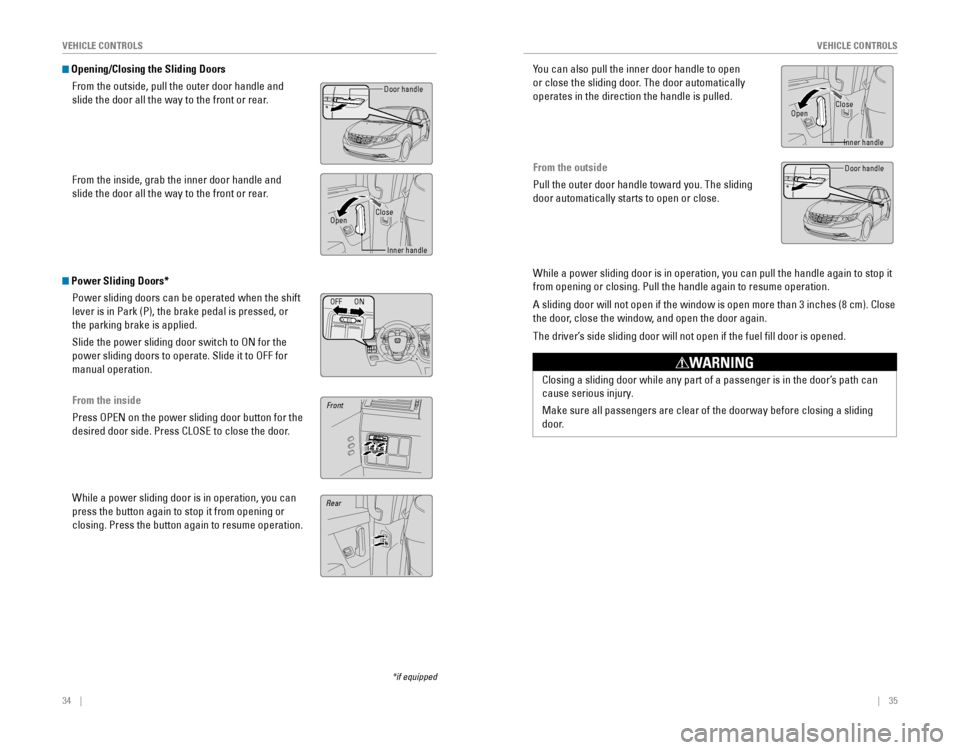
34 || 35
VEHICLE CONTROLSVEHICLE CONTROLS
Opening/Closing the Sliding Doors
From the outside, pull the outer door handle and
slide the door all the way to the front or rear.
From the inside, grab the inner door handle and 
slide the door all the way to the front or rear.
Power Sliding Doors*
Power sliding doors can be operated when the shift 
lever is in Park (P), the brake pedal is pressed, or 
the parking brake is applied.
Slide the power sliding door switch to ON for the
power sliding doors to operate. Slide it to OFF for
manual operation.
From the inside
Press OPEN on the power sliding door button for the 
desired door side. Press CLOSE to close the door.
While a power sliding door is in operation, you can
press the button again to stop it from opening or 
closing. Press the button again to resume operation.
Door handle
OpenClose
Rear
Front
Inner handle
OFFON
*if equipped
Closing a sliding door while any part of a passenger is in the door’s path can
cause serious injury.
Make sure all passengers are clear of the doorway before closing a sliding 
door.
WARNING
You can also pull the inner door handle to open
or close the sliding door. The door automatically
operates in the direction the handle is pulled.
From the outside
Pull the outer door handle toward you. The sliding
door automatically starts to open or close.
While a power sliding door is in operation, you can pull the handle agai\
n to stop it
from opening or closing. Pull the handle again to resume operation.
A sliding door will not open if the window is open more than 3 inches (\
8 cm). Close
the door, close the window, and open the door again.
The driver’s side sliding door will not open if the fuel fill door is opened.
Door handle
OpenClose
Inner handle
Page 22 of 80
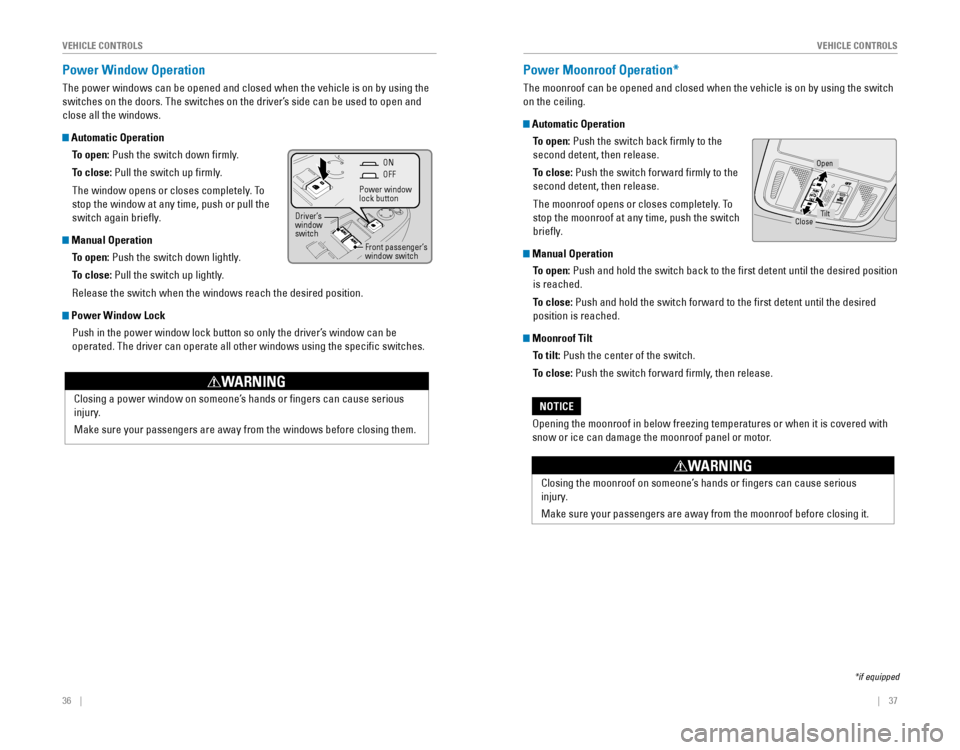
36    || 37
VEHICLE CONTROLSVEHICLE CONTROLS
Power Window Operation
The power windows can be opened and closed when the vehicle is on by using the 
switches on the doors. The switches on the driver’s side can be used to open and 
close all the windows.
Automatic OperationTo open: Push the switch down firmly.
To close: Pull the switch up firmly.
The window opens or closes completely. To
stop the window at any time, push or pull the
switch again briefly.
Manual OperationTo open: Push the switch down lightly.
To close: Pull the switch up lightly.
Release the switch when the windows reach the desired position.
Power Window Lock
Push in the power window lock button so only the driver’s window can be 
operated. The driver can operate all other windows using the specific \
switches.
Closing a power window on someone’s hands or fingers can cause serious
injury.
Make sure your passengers are away from the windows before closing them.
WARNING
Power Moonroof Operation*
The moonroof can be opened and closed when the vehicle is on by using the switch 
on the ceiling.
Automatic Operation To open:
 Push the switch back firmly to the 
second detent, then release.
To close: Push the switch forward firmly to the
second detent, then release.
The moonroof opens or closes completely. To
stop the moonroof at any time, push the switch
briefly.
Manual OperationTo open:
 Push and hold the switch back to the first detent until the desired position 
is reached.
To close: Push and hold the switch forward to the first detent until the desire\
d
position is reached.
Moonroof TiltTo tilt: Push the center of the switch.
To close: Push the switch forward firmly, then release.
Closing the moonroof on someone’s hands or fingers can cause serious
injury.
Make sure your passengers are away from the moonroof before closing it.
WARNING
Opening the moonroof in below freezing temperatures or when it is covered with 
snow or ice can damage the moonroof panel or motor.
NOTICE
Close
OpenTiltOFF
Power window lock button
Driver’s window
switch Front passenger’s
window switchON
*if equipped
Page 23 of 80
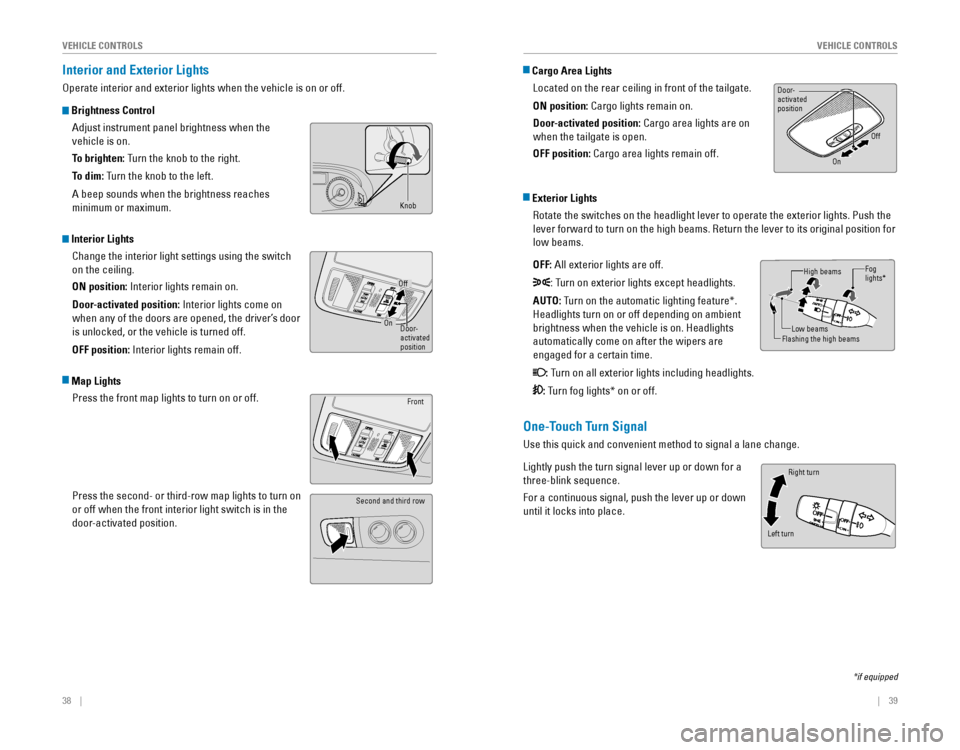
38 || 39
VEHICLE CONTROLSVEHICLE CONTROLS
Interior and Exterior Lights
Operate interior and exterior lights when the vehicle is on or off.
Brightness Control
Adjust instrument panel brightness when the 
vehicle is on.
To brighten:
 Turn the knob to the right.
To dim: Turn the knob to the left.
A beep sounds when the brightness reaches 
minimum or maximum.
Interior Lights
Change the interior light settings using the switch
on the ceiling.
ON position:
 Interior lights remain on.
Door-activated position: Interior lights come on 
when any of the doors are opened, the driver’s door
is unlocked, or the vehicle is turned off.
OFF position:
 Interior lights remain off.
Map LightsPress the front map lights to turn on or off.
Press the second- or third-row map lights to turn on
or off when the front interior light switch is in the
door-activated position.Door
Activated
Position
Of
On
On
Off
Door-
activated
position
Front
Second and third row
One-Touch Turn Signal
Use this quick and convenient method to signal a lane change.
Lightly push the turn signal lever up or down for a
three-blink sequence.
For a continuous signal, push the lever up or down
until it locks into place.
Exterior Lights Rotate the switches on the headlight lever to operate the exterior light\
s. Push the
lever forward to turn on the high beams. Return the lever to its original position for 
low beams.
OFF: All exterior lights are off.
: Turn on exterior lights except headlights.
AUTO: Turn on the automatic lighting feature*. 
Headlights turn on or off depending on ambient 
brightness when the vehicle is on. Headlights 
automatically come on after the wipers are
engaged for a certain time.
: Turn on all exterior lights including headlights.
: Turn fog lights* on or off.
High beams
Low beamsFlashing the high beams
Fog
lights*
Cargo Area LightsLocated on the rear ceiling in front of the tailgate.
ON position: Cargo lights remain on.
Door-activated position: Cargo area lights are on
when the tailgate is open.
OFF position: Cargo area lights remain off.
Door-activated
position
OnOff
Left turn
Right turn
*if equipped
Knob
Page 24 of 80
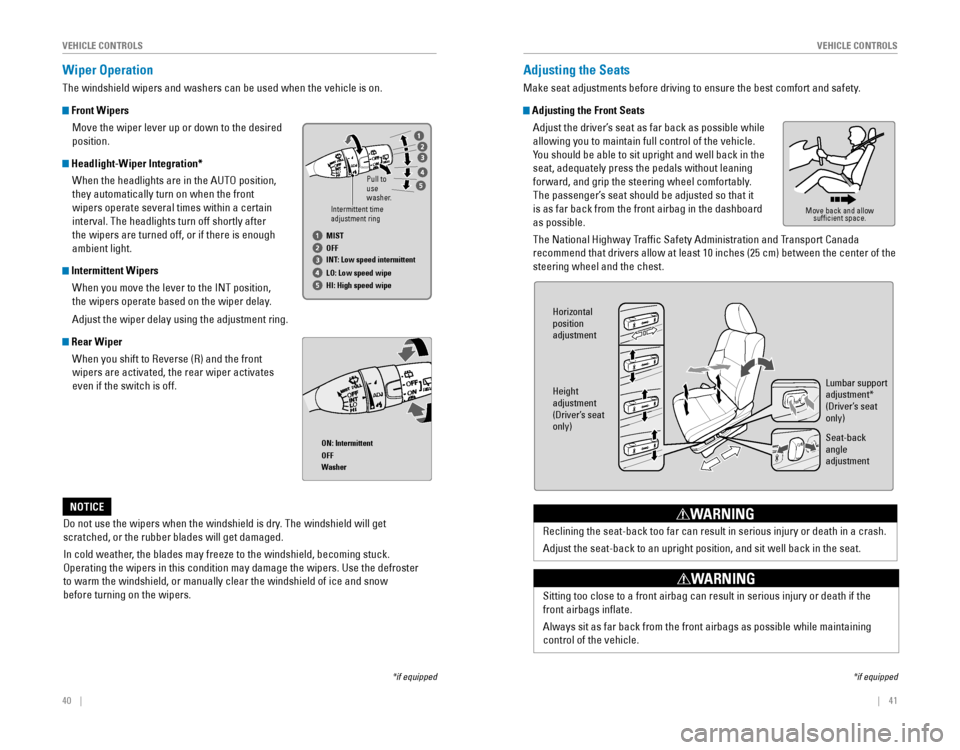
40 || 41
VEHICLE CONTROLSVEHICLE CONTROLS
Wiper Operation
The windshield wipers and washers can be used when the vehicle is on.
Front Wipers
Move the wiper lever up or down to the desired
position.
Headlight-Wiper Integration*When the headlights are in the AUTO position,
they automatically turn on when the front
wipers operate several times within a certain
interval. The headlights turn off shortly after
the wipers are turned off, or if there is enough
ambient light.
Intermittent Wipers
When you move the lever to the INT position, 
the wipers operate based on the wiper delay.
Adjust the wiper delay using the adjustment ring.
Rear WiperWhen you shift to Reverse (R) and the front
wipers are activated, the rear wiper activates
even if the switch is off.
ON: Intermittent
OFF
Washer
Intermittent timeadjustment ring Pull to
use
washer.
MIST
OFF
INT: Low speed intermittent
LO: Low speed wipe
HI: High speed wipe
Do not use the wipers when the windshield is dry. The windshield will get 
scratched, or the rubber blades will get damaged.
In cold weather, the blades may freeze to the windshield, becoming stuck. 
Operating the wipers in this condition may damage the wipers. Use the de\
froster
to warm the windshield, or manually clear the windshield of ice and snow
before turning on the wipers.
NOTICE
Adjusting the Seats
Make seat adjustments before driving to ensure the best comfort and safety.
Adjusting the Front Seats
Adjust the driver’s seat as far back as possible while 
allowing you to maintain full control of the vehicle.
You should be able to sit upright and well back in the 
seat, adequately press the pedals without leaning 
forward, and grip the steering wheel comfortably. 
The passenger’s seat should be adjusted so that it 
is as far back from the front airbag in the dashboard 
as possible.
The National Highway Traffic Safety Administration and Transport Canada
recommend that drivers allow at least 10 inches (25 cm) between the center of the 
steering wheel and the chest.
Reclining the seat-back too far can result in serious injury or death in a crash.
Adjust the seat-back to an upright position, and sit well back in the seat.
WARNING
Move back and allow sufficient space.
Horizontal position
adjustment
Height
adjustment
(Driver’s seat only) Lu
mbar support
adjustment*
(Driver’s seat only)
Seat-back angle
adjustment
Sitting too close to a front airbag can result in serious injury or death if the 
front airbags inflate.
Always sit as far back from the front airbags as possible while maintaining 
control of the vehicle.
WARNING
*if equipped*if equipped
g unclear
g unclear
Page 25 of 80
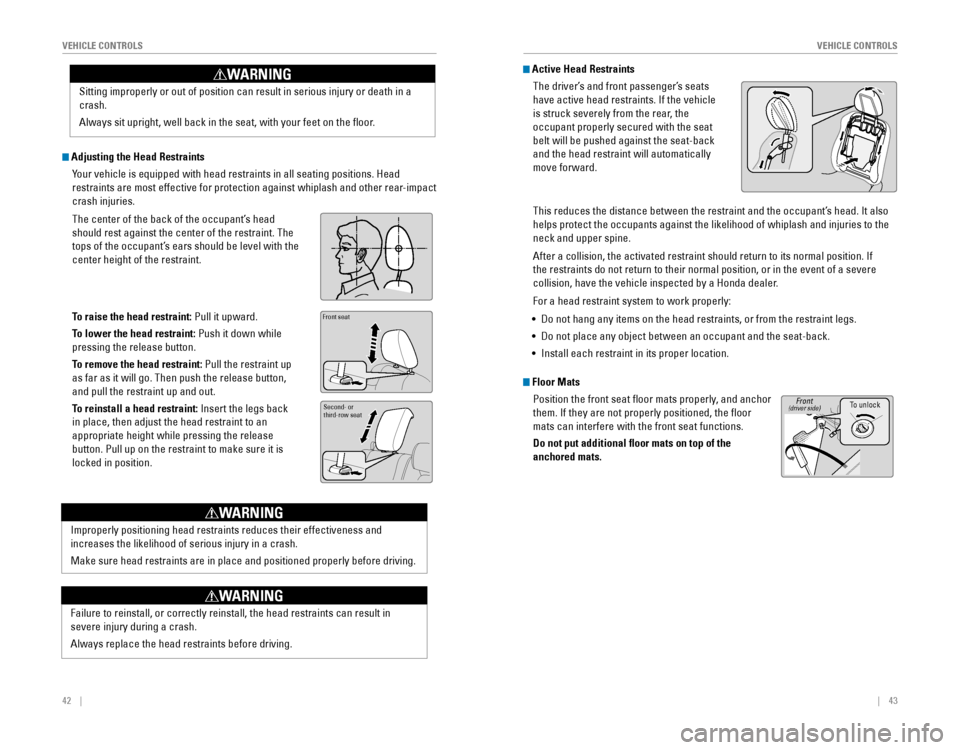
42 || 43
VEHICLE CONTROLSVEHICLE CONTROLS
Sitting improperly or out of position can result in serious injury or de\
ath in a
crash.
Always sit upright, well back in the seat, with your feet on the floor.
WARNING
Adjusting the Head Restraints
Your vehicle is equipped with head restraints in all seating positions. Head 
restraints are most effective for protection against whiplash and other \
rear-impact
crash injuries.
The center of the back of the occupant’s head 
should rest against the center of the restraint. The
tops of the occupant’s ears should be level with the 
center height of the restraint.
To raise the head restraint: Pull it upward.
To lower the head restraint: Push it down while
pressing the release button.
To remove the head restraint: Pull the restraint up
as far as it will go. Then push the release button, 
and pull the restraint up and out.
To reinstall a head restraint:
 Insert the legs back 
in place, then adjust the head restraint to an
appropriate height while pressing the release
button. Pull up on the restraint to make sure it is 
locked in position.
Position head in the
center of the head
restraint.Front seat
Second- or
third-row seat
Improperly positioning head restraints reduces their effectiveness and 
increases the likelihood of serious injury in a crash.
Make sure head restraints are in place and positioned properly before driving.
Failure to reinstall, or correctly reinstall, the head restraints can re\
sult in
severe injury during a crash.
Always replace the head restraints before driving.
WARNING
WARNING
Active Head Restraints
The driver’s and front passenger’s seats
have active head restraints. If the vehicle 
is struck severely from the rear, the
occupant properly secured with the seat
belt will be pushed against the seat-back 
and the head restraint will automatically
move forward.
This reduces the distance between the restraint and the occupant’s head. It also 
helps protect the occupants against the likelihood of whiplash and injur\
ies to the
neck and upper spine.
After a collision, the activated restraint should return to its normal position. If 
the restraints do not return to their normal position, or in the event o\
f a severe
collision, have the vehicle inspected by a Honda dealer.
For a head restraint system to work properly:
• 
Do not hang any items on the head restraints, or from the restraint legs.
• Do not place any object between an occupant and the seat-back.
• Install each restraint in its proper location.
Floor Mats Position the front seat floor mats properly, and anchor
them. If they are not properly positioned, the floor 
mats can interfere with the front seat functions.
Do not put additional floor mats on top of the
anchored mats.
To unlockFront(driver side)
Page 26 of 80
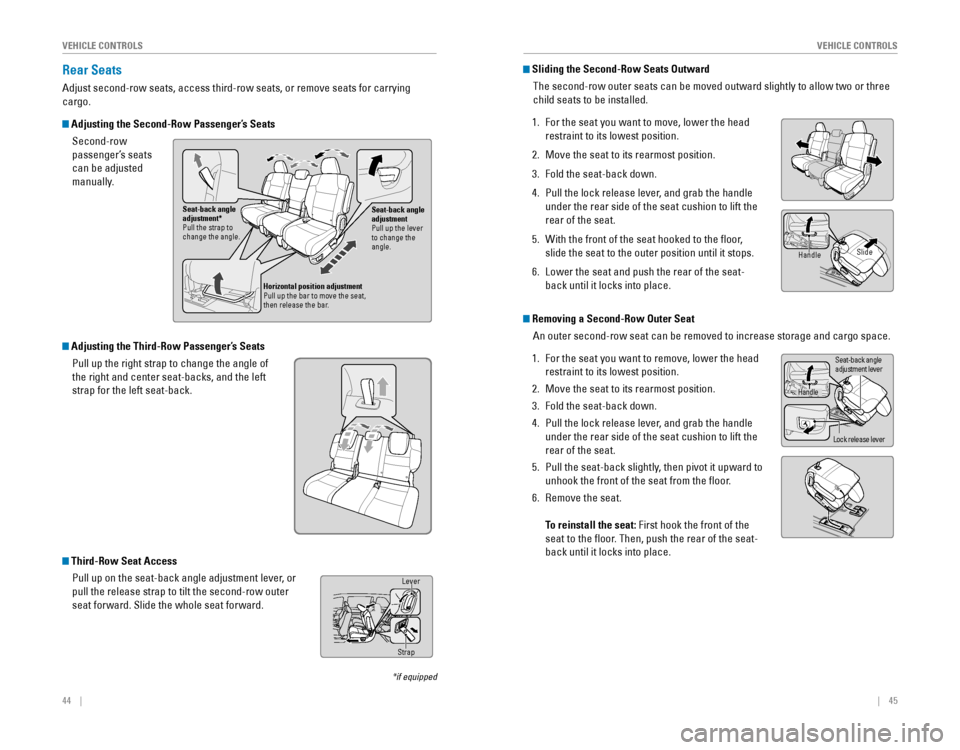
44 || 45
VEHICLE CONTROLSVEHICLE CONTROLS
Seat-back angle adjustment
Pull up the lever
to change the
angle.
Seat-back angle
adjustment*
Pull the strap to
change the angle.
Horizontal position adjustment
Pull up the bar to move the seat, then release the bar.
Rear Seats
Adjust second-row seats, access third-row seats, or remove seats for carrying
cargo.
Adjusting the Second-Row Passenger’s SeatsSecond-row
passenger’s seats
can be adjusted 
manually.
*if equipped
Sliding the Second-Row Seats Outward
The second-row outer seats can be moved outward slightly to allow two or three 
child seats to be installed.
1. For the seat you want to move, lower the head
restraint to its lowest position.
2. Move the seat to its rearmost position.
3. Fold the seat-back down. 
4. Pull the lock release lever, and grab the handle 
under the rear side of the seat cushion to lift the
rear of the seat.
5. With the front of the seat hooked to the floor,
slide the seat to the outer position until it stops.
6. Lower the seat and push the rear of the seat-
back until it locks into place.
HandleSlide
Removing a Second-Row Outer Seat
An outer second-row seat can be removed to increase storage and cargo space.
1. For the seat you want to remove, lower the head
restraint to its lowest position.
2. Move the seat to its rearmost position.
3. Fold the seat-back down. 
4. Pull the lock release lever, and grab the handle 
under the rear side of the seat cushion to lift the
rear of the seat.
5. Pull the seat-back slightly, then pivot it upward to 
unhook the front of the seat from the floor.
6. Remove the seat.
To reinstall the seat: First hook the front of the
seat to the floor. Then, push the rear of the seat-
back until it locks into place.
Handle
Lock release lever
Seat-back angleadjustment lever
Third-Row Seat Access
Pull up on the seat-back angle adjustment lever, or 
pull the release strap to tilt the second-row outer
seat forward. Slide the whole seat forward.Lever
Strap
Adjusting the Third-Row Passenger’s SeatsPull up the right strap to change the angle of
the right and center seat-backs, and the left 
strap for the left seat-back.
Page 27 of 80
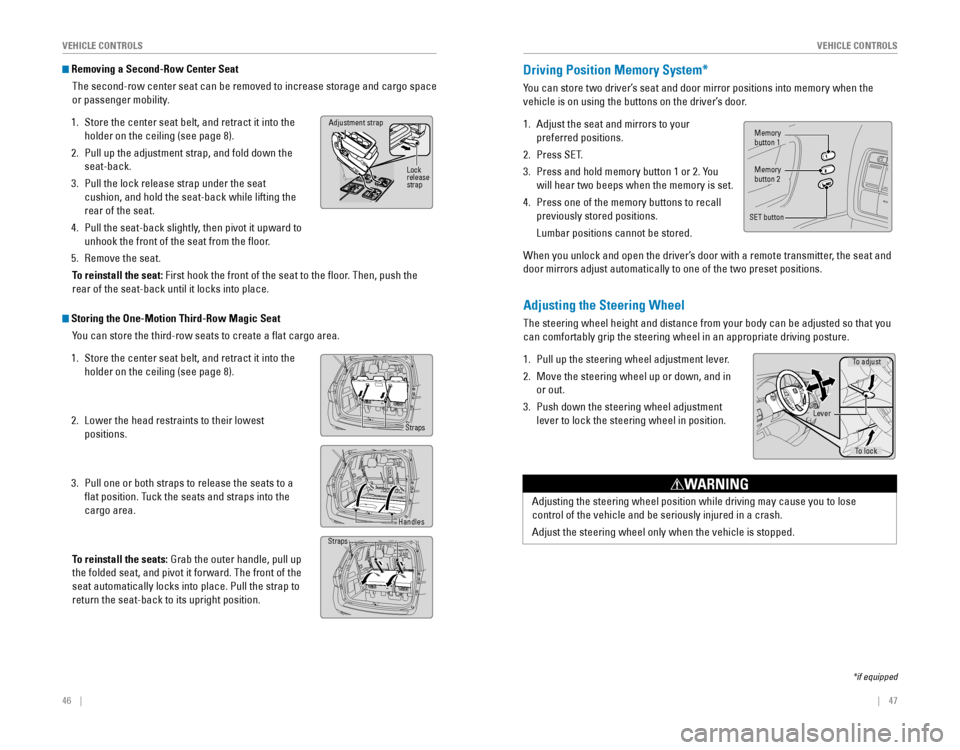
46    || 47
VEHICLE CONTROLSVEHICLE CONTROLS
Removing a Second-Row Center Seat
The second-row center seat can be removed to increase storage and cargo space 
or passenger mobility.
1. Store the center seat belt, and retract it into the 
holder on the ceiling (see page 8).
2. Pull up the adjustment strap, and fold down the
seat-back.
3. Pull the lock release strap under the seat
cushion, and hold the seat-back while lifting the 
rear of the seat.
4. Pull the seat-back slightly, then pivot it upward to 
unhook the front of the seat from the floor.
5. Remove the seat.
To reinstall the seat: First hook the front of the seat to the floor. Then, push the
rear of the seat-back until it locks into place.
Adjustment strap
Lock
release
strap
Storing the One-Motion Third-Row Magic Seat You can store the third-row seats to create a flat cargo area.
1. Store the center seat belt, and retract it into the 
holder on the ceiling (see page 8).
2. Lower the head restraints to their lowest
positions.
3. Pull one or both straps to release the seats to a 
flat position. Tuck the seats and straps into the
cargo area.
To reinstall the seats:
 Grab the outer handle, pull up 
the folded seat, and pivot it forward. The front of the
seat automatically locks into place. Pull the strap to
return the seat-back to its upright position.
Straps
Handles
Straps
Adjusting the Steering Wheel
The steering wheel height and distance from your body can be adjusted so that you 
can comfortably grip the steering wheel in an appropriate driving posture.
1. Pull up the steering wheel adjustment lever.
2. Move the steering wheel up or down, and in
or out.
3. Push down the steering wheel adjustment
lever to lock the steering wheel in position.
Adjusting the steering wheel position while driving may cause you to los\
e
control of the vehicle and be seriously injured in a crash.
Adjust the steering wheel only when the vehicle is stopped.
WARNING
To adjust
To lock
Lever
Driving Position Memory System*
You can store two driver’s seat and door mirror positions into memory when the
vehicle is on using the buttons on the driver’s door.
1. Adjust the seat and mirrors to your
preferred positions.
2. Press SET.
3. Press and hold memory button 1 or 2. You 
will hear two beeps when the memory is set.
4. Press one of the memory buttons to recall 
previously stored positions.
Lumbar positions cannot be stored.
When you unlock and open the driver’s door with a remote transmitter, the seat and
door mirrors adjust automatically to one of the two preset positions.
Memorybutton 1
Memorybutton 2
SET button
*if equipped
Page 28 of 80
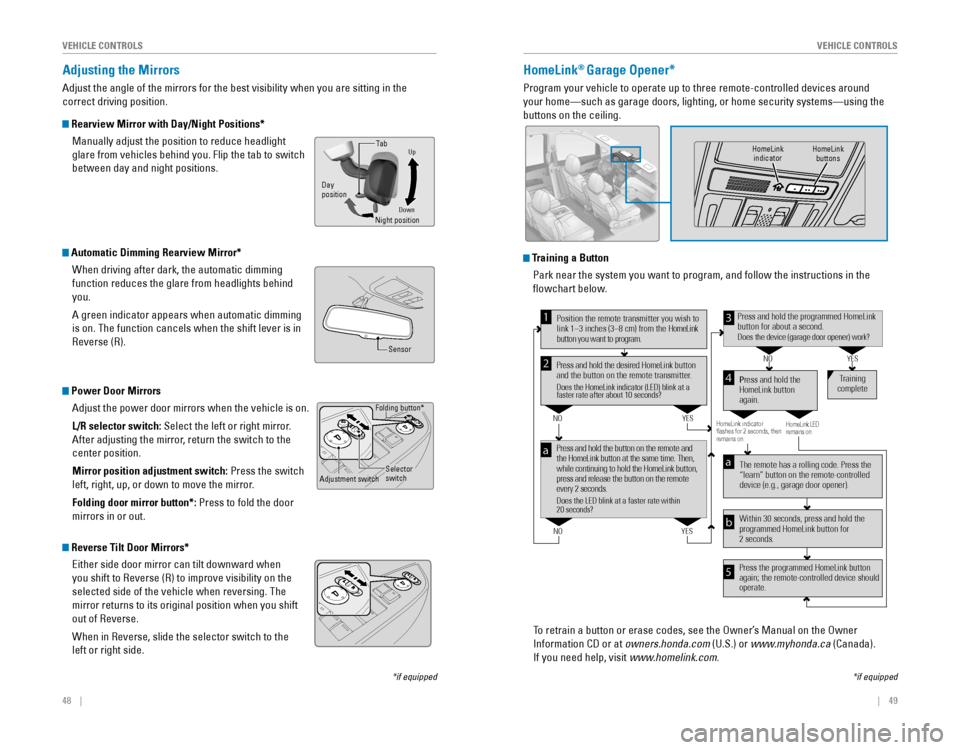
48 || 49
VEHICLE CONTROLSVEHICLE CONTROLS
Folding button*
Adjustment switchSelector
switch
*if equipped
Adjusting the Mirrors
Adjust the angle of the mirrors for the best visibility when you are sitting in the 
correct driving position.
Rearview Mirror with Day/Night Positions*
Manually adjust the position to reduce headlight
glare from vehicles behind you. Flip the tab to switch 
between day and night positions.
Automatic Dimming Rearview Mirror*When driving after dark, the automatic dimming
function reduces the glare from headlights behind 
you.
A green indicator appears when automatic dimming
is on. The function cancels when the shift lever is in
Reverse (R).
Power Door MirrorsAdjust the power door mirrors when the vehicle is on.
L/R selector switch: Select the left or right mirror.
After adjusting the mirror, return the switch to the
center position.
Mirror position adjustment switch: Press the switch
left, right, up, or down to move the mirror.
Folding door mirror button*: Press to fold the door
mirrors in or out.
Reverse Tilt Door Mirrors*
Either side door mirror can tilt downward when 
you shift to Reverse (R) to improve visibility on the 
selected side of the vehicle when reversing. The
mirror returns to its original position when you shift
out of Reverse.
When in Reverse, slide the selector switch to the
left or right side.
DownNight positionTa b
Day
position
Up
Sensor
HomeLink® Garage Opener*
Program your vehicle to operate up to three remote-controlled devices ar\
ound
your home—such as garage doors, lighting, or home security systems—\
using the
buttons on the ceiling.
Training a Button Park near the system you want to program, and follow the instructions in\
the
flowchart below.
To retrain a button or erase codes, see the Owner’s Manual on the Owner 
Information CD or at owners.honda.com (U.S.) or www.myhonda.ca (Canada).
If you need help, visit www.homelink.com.
Press and hold the button on the remote and
the HomeLink button at the same time. Then,
while continuing to hold the HomeLink button,
press and release the button on the remote
every 2 seconds.
Does the LED blink at a faster rate within
20 seconds?
Press and hold the
HomeLink button
again. Tr
aining
complete
YES
NO
HomeLink indicator
� ashes for 2 seconds, then
r emains on. HomeLink LED
remains on.YES
NO
YES
NO
Position the remote transmitter you wish to
link 1–3 inches (3–8 cm) from the HomeLink
button you want to program.1
Press and hold the desired HomeLink button
and the button on the remote transmitter.
Does the HomeLink indicator (LED) blink at a
faster rate after about 10 seconds?
2
a
The remote has a rolling code. Press the
“learn” button on the remote-controlled
device (e.g., garage door opener).
Press the programmed HomeLink button
again; the remote-controlled device should
operate. Within 30 seconds, press and hold the
programmed HomeLink button for
2 seconds.a
Press and hold the programmed HomeLink
button for about a second.
Does the device (garage door opener) work ?
3
b
4
5
*if equipped
HomeLink
indicator HomeLink
buttons
Page 29 of 80
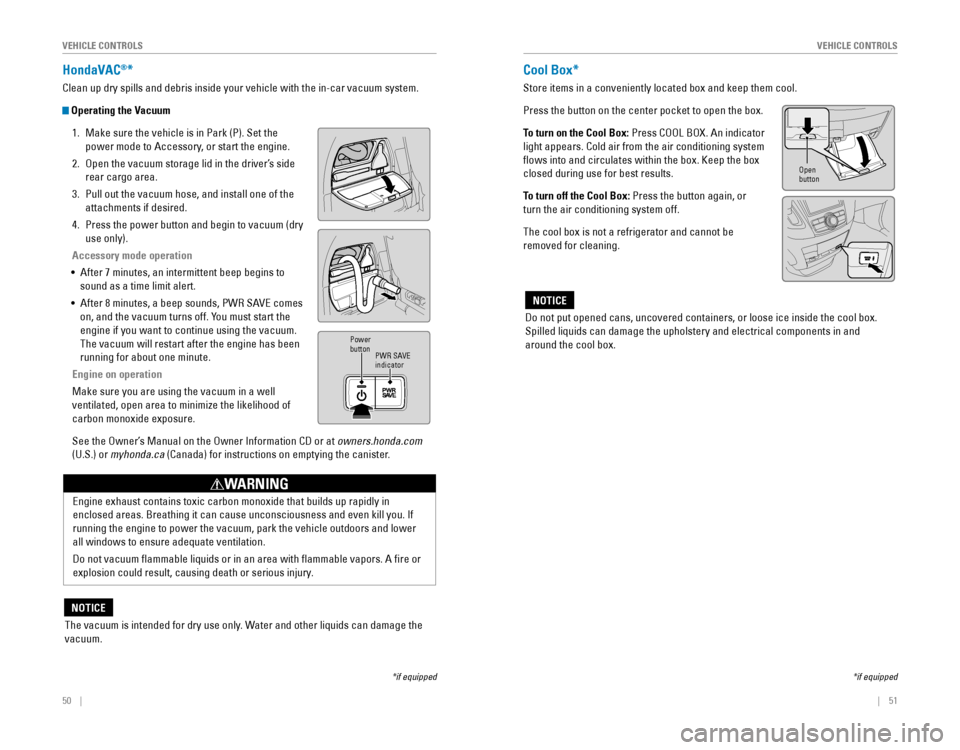
50 || 51
VEHICLE CONTROLSVEHICLE CONTROLS
HondaVAC®*
Clean up dry spills and debris inside your vehicle with the in-car vacuum system.
Operating the Vacuum
1. Make sure the vehicle is in Park (P). Set the
power mode to Accessory, or start the engine.
2. Open the vacuum storage lid in the driver’s side
rear cargo area.
3. Pull out the vacuum hose, and install one of the
attachments if desired.
4. Press the power button and begin to vacuum (dry 
use only).
Accessory mode operation
• 
After 7 minutes, an intermittent beep begins to 
sound as a time limit alert.
• 
After 8 minutes, a beep sounds, PWR SAVE comes 
on, and the vacuum turns off. You must start the
engine if you want to continue using the vacuum.
The vacuum will restart after the engine has been 
running for about one minute.
Engine on operation
Make sure you are using the vacuum in a well
ventilated, open area to minimize the likelihood of 
carbon monoxide exposure.
See the Owner’s Manual on the Owner Information CD or at owners.honda.com
(U.S.) or myhonda.ca (Canada) for instructions on emptying the canister.
PWR SAVEindicator
Power
button
Engine exhaust contains toxic carbon monoxide that builds up rapidly in 
enclosed areas. Breathing it can cause unconsciousness and even kill you. If 
running the engine to power the vacuum, park the vehicle outdoors and lo\
wer
all windows to ensure adequate ventilation.
Do not vacuum flammable liquids or in an area with flammable vapors. A fire or 
explosion could result, causing death or serious injury.
WARNING
The vacuum is intended for dry use only. Water and other liquids can damage the 
vacuum.
NOTICE
*if equipped
Cool Box*
Store items in a conveniently located box and keep them cool.
Press the button on the center pocket to open the box.
To turn on the Cool Box:
Press COOL BOX. An indicator
light appears. Cold air from the air conditioning system
flows into and circulates within the box. Keep the box 
closed during use for best results.
To turn off the Cool Box: Press the button again, or 
turn the air conditioning system off.
The cool box is not a refrigerator and cannot be 
removed for cleaning.
Do not put opened cans, uncovered containers, or loose ice inside the cool box. 
Spilled liquids can damage the upholstery and electrical components in and 
around the cool box.
NOTICE
*if equipped
Open
button
Page 30 of 80
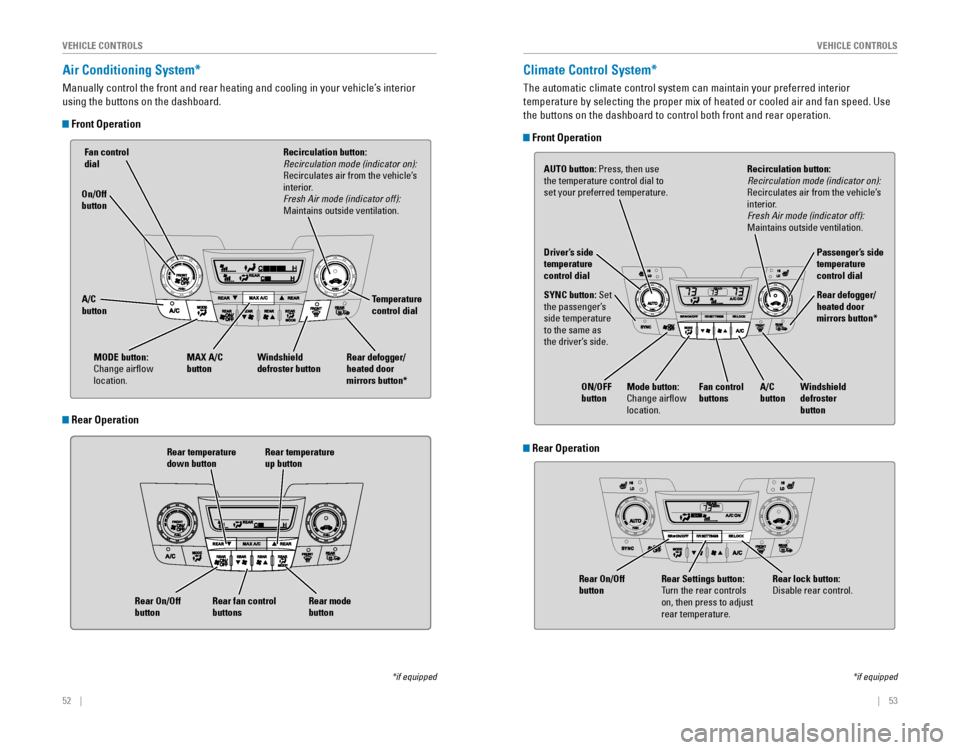
52 || 53
VEHICLE CONTROLSVEHICLE CONTROLS
Air Conditioning System*
Manually control the front and rear heating and cooling in your vehicle’\
s interior
using the buttons on the dashboard.
Front Operation
Fan control dial
A/C
button MAX A/C
button Windshield
defroster button Temperature
control dial
Rear temperature
down button Rear temperature
up buttonRecirculation button: Recirculation mode (indicator on):
Recirculates air from the vehicle’s
interior.
Fresh Air mode (indicator off):
Maintains outside ventilation.
Rear defogger/
heated door
mirrors button*
Rear fan control
buttons
On/Off
button
Rear On/Off
button
Rear mode
button
MODE button:
Change airflow
location.
*if equipped
Climate Control System*
The automatic climate control system can maintain your preferred interio\
r
temperature by selecting the proper mix of heated or cooled air and fan speed. Use 
the buttons on the dashboard to control both front and rear operation.
Front Operation
AUTO button: Press, then use
the temperature control dial to
set your preferred temperature.
SYNC button: Set
the passenger’s
side temperature
to the same as
the driver’s side. Driver’s side
temperature
control dial
A/C
buttonPassenger’s side
temperature
control dial
Recirculation button: Recirculation mode (indicator on):
Recirculates air from the vehicle’s
interior.
Fresh Air mode (indicator off):
Maintains outside ventilation.
Rear defogger/
heated door
mirrors button*
Windshield
defroster
button
Fan control
buttons
ON/OFF
button
Mode button:
Change airflow
location.
*if equipped
Rear Operation
Rear Operation
Rear lock button: Disable rear control.Rear Settings button:
Turn the rear controls
on, then press to adjust
rear temperature.
Rear On/Off
button